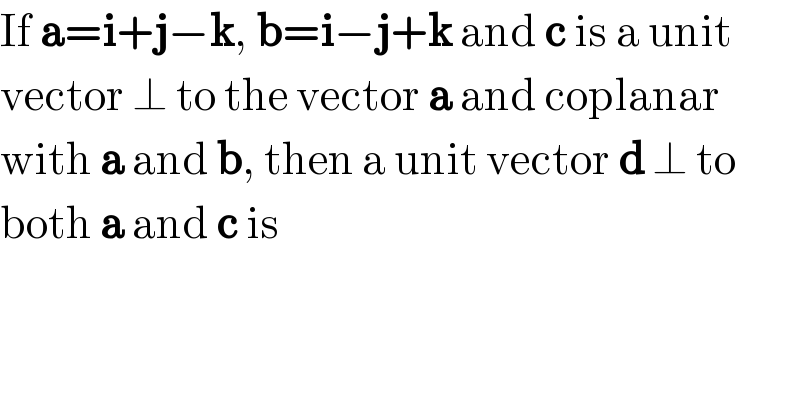
Question and Answers Forum
Question Number 54419 by gunawan last updated on 03/Feb/19

Answered by tanmay.chaudhury50@gmail.com last updated on 03/Feb/19
![c=xa+yb c=x(i+j−k)+y(i−j+k) c=i(x+y)+j(x−y)+k(−x+y) c.a=0 [i(x+y)+j(x−y)+k(−x+y)].[i+j−k]=0 (x+y)+(x−y)+(−x+y)(−1)=0 x+y+x−y+x−y=0 3x−y=0.....(1)eqn c=i(x+y)+j(x−y)+k(−x+y) c=i(x+3x)+j(x−3x)+k(−x+3x) c=i(4x)+j(−2x)+k(2x) given (√(16x^2 +4x^2 +4x^2 )) =1 (√(24x^2 )) =1 x=±(1/(√(24))) considering +ve value only...x=(1/(√(24))) y=(3/(√(24))) c=i(x+y)+j(x−y)+k(−x+y) c=i((4/(√(24))))+j(((−2)/(√(24))))+k((2/(√(24)))) considering −ve sign... c=i(((−4)/(√(24))))+j((2/(√(24))))+k(((−2)/(√(24)))) d=((a×c)/(∣a×c∣)) now a×c [i j k ] [1 1 −1 ] [(4/(√(24))) ((−2)/(√(24))) (2/(√(24)))] now you solve the remaining...](Q54437.png)
| ||
Question and Answers Forum | ||
Question Number 54419 by gunawan last updated on 03/Feb/19 | ||
 | ||
Answered by tanmay.chaudhury50@gmail.com last updated on 03/Feb/19 | ||
![c=xa+yb c=x(i+j−k)+y(i−j+k) c=i(x+y)+j(x−y)+k(−x+y) c.a=0 [i(x+y)+j(x−y)+k(−x+y)].[i+j−k]=0 (x+y)+(x−y)+(−x+y)(−1)=0 x+y+x−y+x−y=0 3x−y=0.....(1)eqn c=i(x+y)+j(x−y)+k(−x+y) c=i(x+3x)+j(x−3x)+k(−x+3x) c=i(4x)+j(−2x)+k(2x) given (√(16x^2 +4x^2 +4x^2 )) =1 (√(24x^2 )) =1 x=±(1/(√(24))) considering +ve value only...x=(1/(√(24))) y=(3/(√(24))) c=i(x+y)+j(x−y)+k(−x+y) c=i((4/(√(24))))+j(((−2)/(√(24))))+k((2/(√(24)))) considering −ve sign... c=i(((−4)/(√(24))))+j((2/(√(24))))+k(((−2)/(√(24)))) d=((a×c)/(∣a×c∣)) now a×c [i j k ] [1 1 −1 ] [(4/(√(24))) ((−2)/(√(24))) (2/(√(24)))] now you solve the remaining...](Q54437.png) | ||
| ||